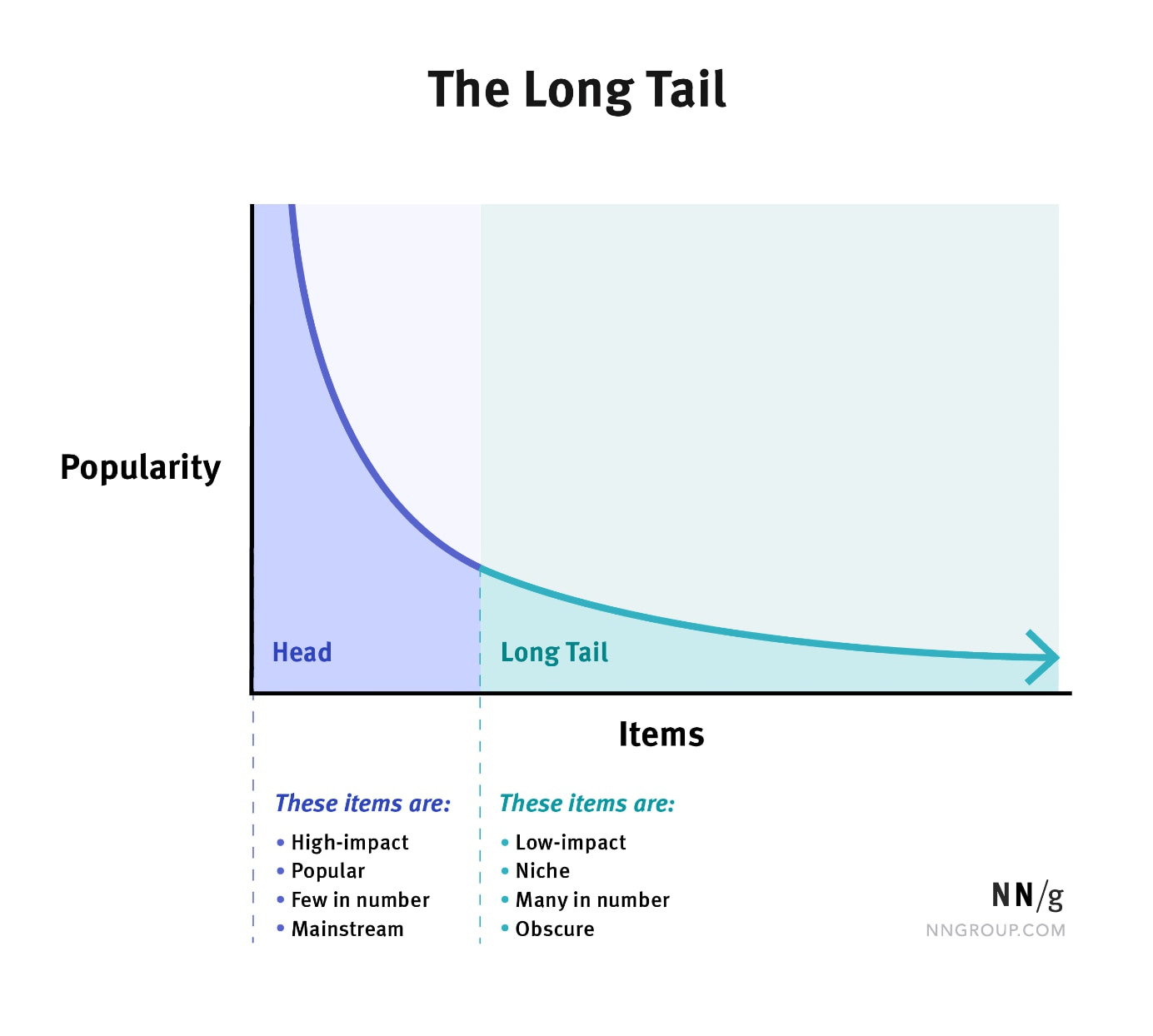Wednesday W.O.W - Long Tail Markets 🛒🛍️🐍
[5 min read] Your mid-week bite sized treat on emerging tech on our journey to the Metaverse. Learn why Long Tail strategies are poised to play a big role in the future of commerce & capital markets

A nibble of knowledge in your inbox every Wednesday with a simple format:
🇼 What the technology is.
🇴 Objective(s) - what is it trying to achieve, with some examples
🇼 Why it is important.
This is week 48 of the 520 weeks of writing I have committed to, a decade of documenting our physical and digital lives converge.
🇼 What Are Long Tail Markets?
The long tail is a concept that allows companies to realise significant profits by selling low volumes of hard-to-find items to many customers. The term was first coined in 2004 by Chris Anderson who took this concept mainstream with his New York Times bestselling book “The Long Tail”.
Long Tail markets diverge from the conventional focus on high-demand, popular products. This conventional wisdom is grounded in the reality that a brick-and-mortar shop has limited space, therefore it makes sense to focus on what is most popular. Targeting a Long Tail market strategy essentially acknowledges that a multitude of lesser-known products, even with modest individual sales, can cumulatively contribute substantially to a business's revenue.
This concept becomes particularly relevant in the digital space, where the virtual shelves are unlimited. Businesses can curate a catalogue that extends far beyond the constraints of physical stores, allowing them to tap into the depth and breadth of niche products.
🇴 Objective - How to Target Long Tail Markets
The primary objective of venturing into Long Tail markets is diversification. This diversification manifests in two significant ways:
Product Diversification: By exploring niche products, businesses can cater to a multitude of consumer segments, each with its unique preferences and needs. This diversification strategy aims to offer a broad spectrum of products, ensuring that there's something for everyone. This approach opens doors to different cultural groups and demographics, as products can be tailored to specific tastes and languages.
Customer Base Diversification: Long Tail targeting also aims to diversify the customer base. Instead of relying solely on a narrow segment of high-demand products, businesses attract a broader audience with varied interests. The cumulative effect of niche product sales can significantly bolster a company's overall revenue.
Crucially, Long Tail targeting is not about sidelining popular products; it's about supplementing them. The goal is to strike a balance where the niche products are easily discoverable and accessible to a broad audience. Here are some examples of this done well:
Amazon: Amazon is a prime example of how Long Tail markets can lead to tremendous success. While they sell mainstream products, their marketplace also allows smaller sellers to offer niche products. This approach greatly expands their product selection, attracting a wide variety of customers.
eBay: eBay disrupted traditional retail by creating an online marketplace where users could buy and sell a vast array of products, including unique and rare items (Beanie Babies!). This approach tapped into the Long Tail of consumer interests, making it a thriving platform.
Etsy: Etsy specialises in handmade and unique products created by individual artisans and crafters. By focusing on niche markets like handmade jewelry, vintage goods, and custom crafts, they've cultivated a loyal customer base seeking one-of-a-kind items.
Spotify: In the music streaming industry, Spotify's extensive library includes not only chart-toppers but also a wide range of lesser-known artists and genres. This approach caters to music enthusiasts with diverse tastes, exemplifying Long Tail targeting.
YouTube: YouTube allows content creators of all sizes to share their videos with a global audience. This platform showcases an array of niche content, from educational channels to unique hobbies, making it an ideal Long Tail success story.
🇼 Why is This Concept Relevant to the Future of Commerce & Capital Markets?
Looking ahead to the future of commerce and capital markets, the concept of Long Tail markets remains relevant for several reasons:
Digital Transformation: In the digital age, the relevance of Long Tail markets is amplified. Online platforms, and the emerging Metaverse, provide the perfect playground for businesses to experiment with diverse product offerings. Data-driven insights, recommendation algorithms, and targeted marketing have made it easier to identify and reach niche audiences.
Democratisation of Commerce: Long Tail markets challenge the traditional retail model, where a few bestsellers dominate. This democratisation of commerce empowers businesses of all sizes to find their niche and thrive. It levels the playing field, allowing smaller players to compete effectively.
Data-Driven Personalisation: The Long Tail concept aligns with the increasing focus on data-driven personalization. Businesses can use data intelligence to understand individual preferences and make personalised product recommendations. This not only enhances the customer experience but also drives sales.
Evolving Consumer Behavior: Consumer behavior is evolving, with many seeking unique and specialised products. Long Tail markets cater to this evolving preference for variety and customisation.
To wrap things up, the concept of Long Tail markets challenges traditional business models and remains highly relevant in the digital era. It reflects a shift towards diversification, data-driven strategies, and the empowerment of businesses to find their unique niche in a global marketplace. As the digital landscape continues to evolve, Long Tail strategies are poised to play a pivotal role in the future of commerce and capital markets.
🎬 Bonus watch
This TED talk from 16 years ago where Chris talks us through the concept. Extra treat with the retro TED talk branding and tagline!
That’s all for this week! If you have any organisations in mind that could benefit from learning about emerging technology, be sure to reach out. Educational workshops are one of many consulting services I offer.

